Report Branded or Entangled Steller Sea Lions
Generic Clearance for Citizen Science and Crowdsourcing Projects
Pinniped Entanglement in Marine Debris
Report Branded or Entangled Steller Sea Lions
OMB: 0648-0828
Pinniped Entanglement in Marine Debris
Marine debris adversely impacts at least 260 marine species, including marine mammals, sea turtles, and seabirds.
The Marine Debris Threat
Marine debris is any human-made object discarded, disposed of, or abandoned that enters the marine environment. A large portion of marine debris found in Alaska waters and on its shores is plastic fishing gear and other plastics which degrade slowly, and break into smaller and smaller fragments, affecting all parts of the ecosystem. In 2010, an estimated 17 billion pounds of plastic landed at sea. Every year many seals and sea lions in Alaska unnecessarily suffer or die from ingesting fishing gear or getting caught in marine debris. The Alaska Pinniped Entanglement Group - the Alaska Department of Fish and Game, the Aleut Community of St. Paul Island and NOAA Fisheries - works collaboratively to educate the public about marine debris and pinniped entanglement in Alaska.
Please let NOAA Fisheries know if you see injured, entangled or dead marine mammals in the water or on the beach.
Note: A video that describes what happens to lost and discarded trash and how it can attract the attention of sea lions and seals that can become entangled in it, suffer, and die was here on this webpage but could not be copied to this Word doc.
Types of Marine Debris
Looped Material
Some of the deadliest marine debris is likely to wrap around the neck of the sea lion or seal. The materials that most commonly cause neck entanglements are:
Plastic packing straps
Packing straps cause more than 50% of neck entanglements of Steller sea lions in Alaska
Large black rubber bands
Often used on sport and commercial crab pots
Rope / Line
Nets
Monofilament line
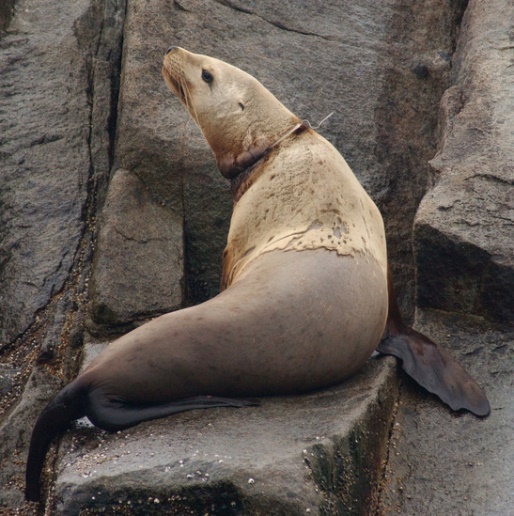
Plastic packing strap on a Steller sea lion. Research permit #358-1564. Photo: ADF&G
Swallowed Materials
Swallowed material includes hooks, lures, and line. These can be “silent killers”, causing unseen injury and death from within. Ingested fishing gear is usually:
Salmon fishery hooks and flashers (lures)
Longline gear
Spinners/spoons
Bait hooks
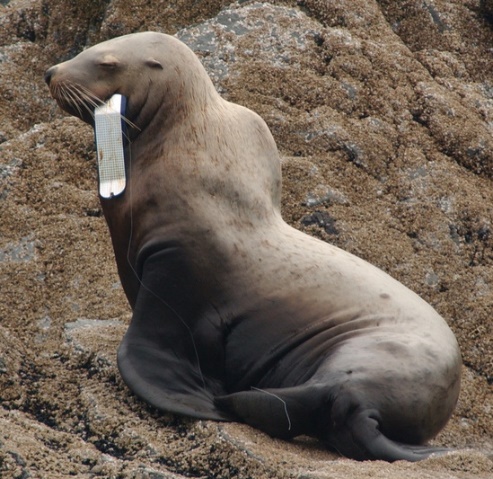
Steller sea lion hooked with a salmon flasher and fishing line. Research permit #358-1564. Photo ADF&G
Sea Lion Entanglement Educational Materials
WARNING: some of the entanglement images may be disturbing.
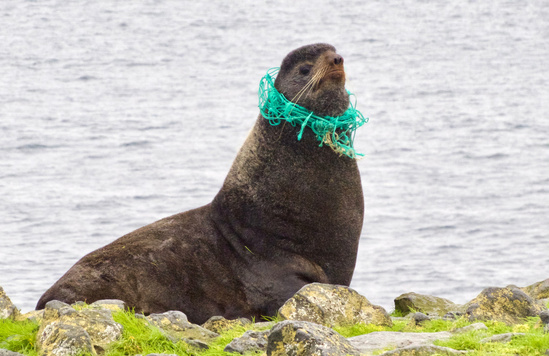
Northern fur seal with a fishing net around its neck. Research permit #14327. Photo ADF&G
Marine Debris in the Pribilof Islands
Northern fur seals can become entangled in commercial fishing debris, primarily trawl net webbing, plastic packing straps, and monofilament line. Fur seals may encounter marine debris during their winter and spring migrations when they spend most of their time in the North Pacific foraging in the transition zone and eddies. They also encounter marine debris in the Bering Sea during their travels to and from their haulouts.
NOAA Fisheries conducts research on fur seal entanglement and works collaboratively with the Tribal Governments of St. Paul and St. George, the Marine Conservation Alliance Foundation and the NOAA Marine Debris Program to reduce the debris on northern fur seal breeding habitat and other coastal areas on the Pribilof Islands.
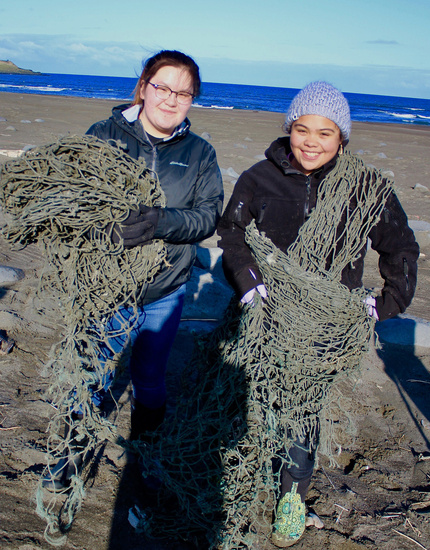
St. Paul students help with a marine debris cleanup. Photo: Veronica Padula, Ecosystem Conservation Office, Aleut Community of St. Paul Island
NOAA Fisheries managers, scientists and tribal co-management partners often observe entangled fur seals on the Pribilof Islands. Through coordination with the Alaska Stranding Network, NOAA Fisheries is able to authorize our tribal co-management partners to respond to entangled northern fur seals when conditions are appropriate. Since the mid-1990s, NOAA Fisheries has trained and authorized tribal members on St. Paul and St. George to monitor and disentangle northern fur seals promoting a strong conservation ethic to further reduce the effects of marine debris on northern fur seals.
The juvenile male fur seal entanglement rate has fluctuated, but is estimated at less than one percent annually for juvenile (two to four-year-old) male seals observed on the Pribilof Islands. However, this rate does not account for seals that become entangled at sea and are unable to return to the breeding grounds.
Adult females and juvenile males are similar in size and are entangled in commonly used 4-inch mesh trawl nets. The observed rates of entanglement for adult females may be lower than they are for juvenile males, but the rates are higher than that of adult males because females are smaller and have a slower rate of growth. Entangled lactating females spend more time at sea feeding than non-entangled females and some entangled females die at sea. As a result, pups with entangled mothers have lower survival rates than other pups.
Sources: Fowler 1985,1987, 2002; Scordino and Fisher 1983; Robson et al. 1999; Williams et al. 2004; DeLong et al. 1988; Feldcamp et al. 1988; Laist 1997; Trites and Larkin 1989.
How to Report Entangled Marine Mammals
Please let us know if you see injured, entangled or dead marine mammals in the water or on the beach. The most important information to collect is the date, location of animal (including latitude and longitude), number of animals, and species. Please don't move or touch the animal.
Stranding Report Phone Numbers (for the general public)
NOAA Fisheries statewide 24-hour stranding hotline: (877) 925-7773 FREE or (877) 9-AKR-PRD
Protected Resources Office:
Juneau: (907) 586-7235
Anchorage: (907) 271-5006
Alaska SeaLife Center Stranding Hotline: (888) 774-7325
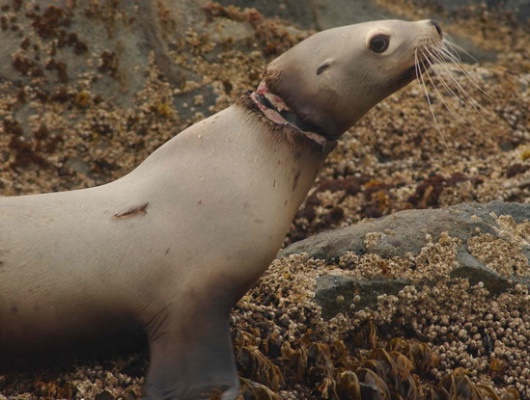
Steller sea lion entangled with a black rubber band. Permit #358-1564. Photo ADF&G
Last updated by Alaska Regional Office on 05/03/2022
| File Type | application/vnd.openxmlformats-officedocument.wordprocessingml.document |
| Author | Joe.I.Terry |
| File Modified | 0000-00-00 |
| File Created | 2023-08-19 |
© 2025 OMB.report | Privacy Policy